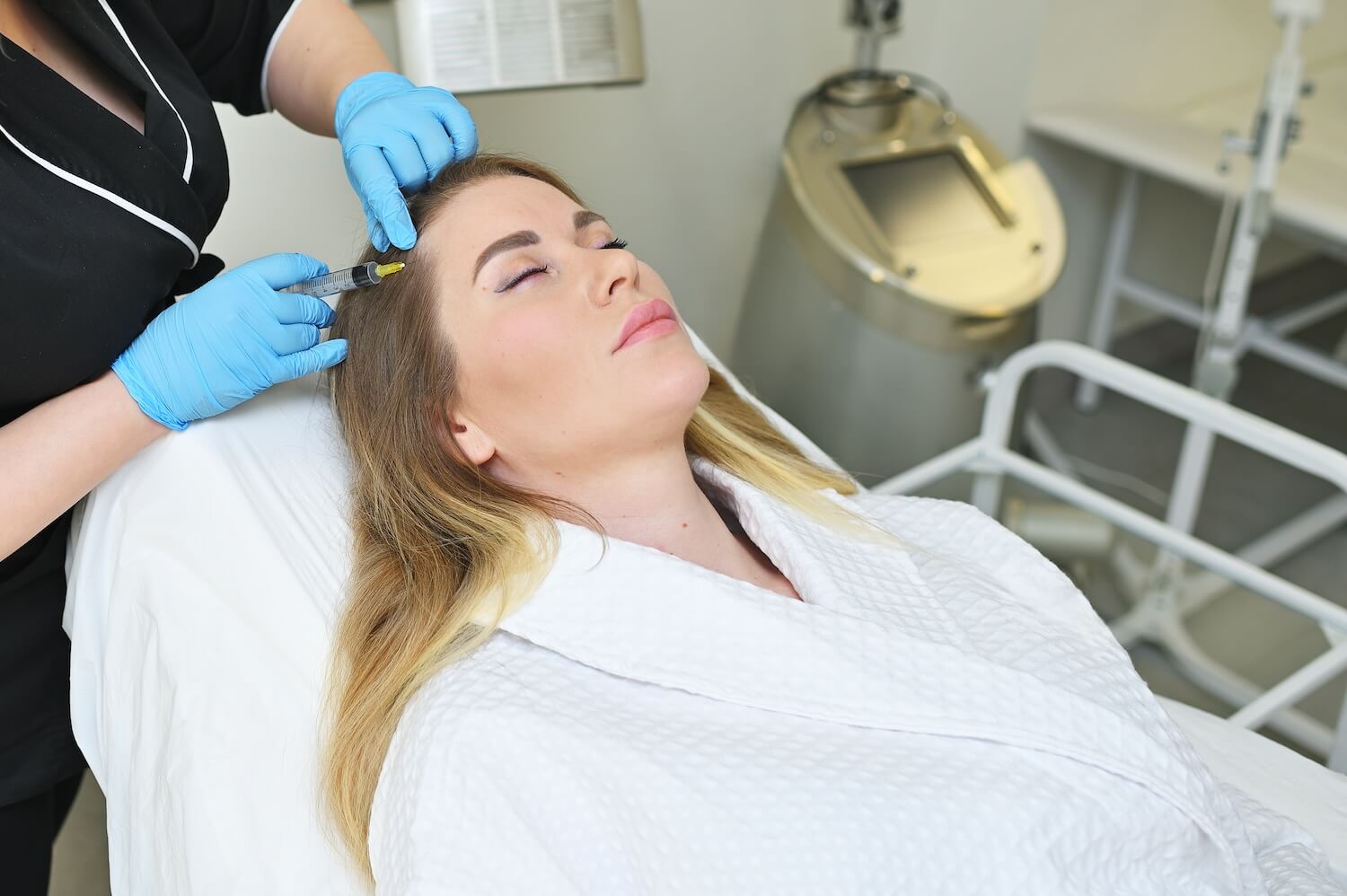Hair loss is a widespread concern, affecting millions of individuals across all ages and backgrounds. This phenomenon can be linked to various factors, from genetics and age to lifestyle, stress, and medical conditions. The impact of hair thinning or hair loss can be profound, often influencing self-esteem, confidence, and overall quality of life. Amidst an array of treatments available—ranging from topical solutions to surgical interventions—PRP (Platelet-Rich Plasma) Scalp Therapy has gained traction as a safe, natural, and effective solution for hair restoration. Using the body’s own growth factors, PRP promotes hair growth, enhances hair density, and strengthens follicles.
This article delves into the advantages of PRP scalp therapy, how it works on a scientific level, who it’s best suited for, and how it compares to other hair restoration options. By the end, you’ll have a comprehensive understanding of why PRP therapy may be the right choice for revitalizing hair health.
PRP Scalp Therapy: An Overview
Platelet-Rich Plasma (PRP) therapy is a regenerative treatment that utilizes concentrated platelets from a patient’s own blood to promote healing and cell regeneration. Platelets, the small cell fragments in our blood, are crucial for clotting and contain various growth factors essential for tissue repair. PRP treatment has been widely used in sports medicine and wound healing and has more recently gained popularity in dermatology for hair and skin rejuvenation.
How PRP Therapy Works for Hair Restoration
- Blood Draw and Preparation: The process starts with a simple blood draw, usually from the arm. The blood is then placed in a centrifuge, which spins it at high speeds to separate the platelets from other blood components.
- Formation of Platelet-Rich Plasma: This concentrated layer, rich in platelets, is collected for the PRP injections. This layer contains a high concentration of growth factors known for their role in cell repair and regeneration.
- Injection into the Scalp: Once the PRP is prepared, it is injected into areas of the scalp experiencing hair thinning or loss. These growth factors in the PRP stimulate inactive hair follicles, boost blood flow, and encourage cell regeneration, thereby creating an environment that promotes hair growth.
Over time, the body’s natural healing mechanisms are activated by the PRP, leading to a gradual increase in hair thickness, volume, and overall scalp health.
Key Benefits of PRP Scalp Therapy
PRP therapy offers a number of benefits that make it an appealing choice for those seeking a non-surgical and natural approach to hair restoration. Let’s explore each in detail:
1. A Natural, Non-Surgical Solution
One of the most appealing aspects of PRP therapy is that it utilizes the body’s own cells for treatment, avoiding foreign substances or chemicals. This natural approach reduces the risk of adverse reactions and makes PRP a viable option for individuals who may be sensitive to other types of hair restoration treatments. Unlike hair transplants or other surgical interventions, PRP does not involve incisions or extended recovery time.
2. Improves Hair Follicle Health and Stimulates Dormant Follicles
Hair follicles can enter a dormant state due to factors such as age, genetics, stress, or nutritional deficiencies. PRP’s growth factors can help “wake up” these inactive follicles, enabling them to begin producing hair again. Additionally, PRP provides a nutrient boost that strengthens existing follicles, promoting stronger, thicker hair growth over time. This is particularly beneficial in the early stages of hair thinning when many follicles are still viable.
3. Minimizes Shedding and Prolongs the Hair Growth Cycle
Hair growth occurs in cycles, with hair shedding occurring naturally as part of the cycle. Excessive shedding, however, can lead to visible thinning. PRP therapy extends the growth phase (anagen phase) of hair while reducing the shedding phase (telogen phase). This adjustment to the hair cycle results in less overall shedding, helping maintain a fuller look for a longer duration.
4. Increases Hair Thickness, Texture, and Density
The gradual effects of PRP therapy lead to increased hair strand thickness, enhancing the overall look and feel of the hair. By boosting blood flow to the scalp and nourishing follicles, PRP improves the texture of individual strands, giving hair a denser and healthier appearance over time.
5. Effective Across Different Types of Hair Loss
PRP therapy is versatile and can address multiple types of hair loss, including:
- Androgenetic Alopecia (Pattern Baldness): The most common form of hair loss, PRP can slow down and even reverse its effects, especially in the early stages.
- Telogen Effluvium: Often triggered by stress or hormonal changes, PRP can help regulate hair growth cycles, minimizing the effects of telogen effluvium.
- Alopecia Areata: Though an autoimmune condition, PRP has shown promise in promoting regrowth in areas affected by alopecia areata.
This adaptability makes PRP an appealing option for people experiencing different types of hair thinning.
6. Minimal Downtime and Quick Recovery
Most patients can resume daily activities immediately after a PRP session. The side effects are typically mild, including some redness, swelling, or tenderness around the injection sites, which usually subside within a day. Unlike surgical procedures, there is no lengthy healing period or need to take time off from regular activities.
7. Boosts Confidence and Self-Esteem
Hair loss can have a profound impact on self-image and confidence. Many individuals report feeling more self-assured and positive after undergoing PRP scalp therapy, as the treatment not only improves hair appearance but also restores a sense of control over one’s appearance.
How PRP Scalp Therapy Works: The Science Behind Hair Growth Stimulation
The success of PRP in hair restoration is attributed to the growth factors contained in platelets. These growth factors include:
- Platelet-Derived Growth Factor (PDGF): Stimulates cell replication and helps form new blood vessels.
- Transforming Growth Factor-Beta (TGF-β): Plays a role in cellular differentiation, aiding in tissue regeneration.
- Vascular Endothelial Growth Factor (VEGF): Promotes blood vessel formation, enhancing blood flow to hair follicles.
- Fibroblast Growth Factor (FGF): Encourages the development and growth of new hair follicle cells.
When injected into the scalp, PRP releases these growth factors into the surrounding tissue, creating an environment rich in nutrients and oxygen. The increase in circulation improves hair follicle health, strengthens existing hair, and encourages new hair growth.
The PRP Treatment Process: Step-by-Step
- Initial Consultation: The PRP journey begins with a consultation, during which a specialist examines the extent and type of hair loss and determines if PRP is a viable option. For optimal results, a personalized treatment plan is developed, often including recommendations for diet, lifestyle changes, or supplements.
- Preparation and Blood Draw: During the treatment, a small amount of blood is drawn, usually from the arm. This blood sample is placed in a centrifuge to separate the platelets, a process that takes about 10-15 minutes.
- PRP Injection: The concentrated PRP is injected into target areas on the scalp using a very fine needle. Some clinics offer numbing cream to minimize discomfort. The procedure is generally well-tolerated, with minimal pain and discomfort.
- Post-Treatment Guidelines: Patients are advised to avoid heavy sun exposure, strenuous activities, and hair treatments (such as dyeing) for a few days. This helps ensure the scalp heals optimally and the treatment is as effective as possible.
- Follow-Up Sessions: PRP therapy is typically performed in multiple sessions. Initial treatments are spaced about a month apart, followed by maintenance sessions every 6-12 months. This ongoing approach ensures continued benefits and optimal results.
Who Is an Ideal Candidate for PRP Scalp Therapy?
PRP is most effective for individuals with early-to-moderate hair thinning or loss. Those who have areas of active follicles or partially dormant ones can benefit significantly from PRP. Ideal candidates are individuals with:
- Androgenetic alopecia (early stage)
- Telogen effluvium or stress-related hair loss
- Good general health without blood clotting disorders or autoimmune diseases that may interfere with PRP’s effectiveness
- Realistic expectations and willingness to undergo multiple sessions for optimal results
Individuals with complete baldness or very advanced hair loss may not experience substantial results from PRP, as the treatment cannot regenerate completely lost follicles.
Comparing PRP Scalp Therapy with Other Hair Restoration Treatments
To determine if PRP is the right choice, it’s helpful to compare it with other hair restoration options:
1. Topical Treatments (Minoxidil)
Topical treatments like minoxidil are widely used and have been shown to promote hair growth, especially in those with early-stage androgenetic alopecia. However, these treatments often require consistent application and may cause scalp irritation. PRP’s effects are longer-lasting and work deeper within the scalp, though results from PRP may take longer to appear.
2. Oral Medications (Finasteride)
Finasteride, a prescription medication, is effective for male pattern hair loss but may cause hormonal side effects, especially in men. PRP is free from these risks, making it a suitable choice for those who prefer a more natural approach.
3. Hair Transplant Surgery
For those with significant hair loss, a hair transplant may provide more immediate results. However, PRP therapy can still complement a transplant by improving follicle health and encouraging new growth, enhancing the overall outcome.
Conclusion
PRP scalp therapy has emerged as a groundbreaking solution for those looking to address hair thinning and loss in a natural, minimally invasive way. By using the body’s own regenerative properties, PRP not only revitalizes hair follicles but also promotes sustained growth, offering hope to individuals dealing with the emotional and physical impact of hair loss.
If you’re considering PRP scalp therapy for hair restoration, consulting with a qualified specialist is the first step towards achieving the fuller, healthier hair you desire. This innovative treatment brings you closer to regaining confidence and rejuvenating your hair with each session. Whether you’re facing early signs of thinning or hoping to enhance your current treatment regimen, PRP offers a scientifically-backed, patient-centered approach to hair restoration.

